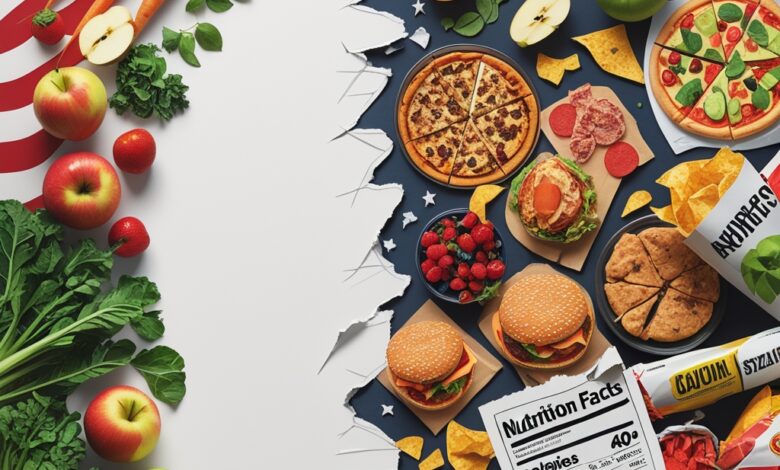Healthy vs Unhealthy Foods in America
Americans Are Struggling to Identify Healthy Foods Here’s How to Make Smarter Choices

Introduction
Healthy eating is the foundation of a vibrant, active, and long life. Yet, many Americans are confused about which foods truly nourish their bodies and which ones might silently harm their health. This confusion isn’t entirely surprising the food industry often markets unhealthy products as “natural” or “wholesome,” and conflicting information about nutrition only adds to the uncertainty.
If you’ve been wondering whether a granola bar is a better choice than a bag of chips, or if plant-based meat is as healthy as it sounds, this article will guide you toward clarity. We’ll tackle common myths, uncover truths about healthy eating, and give you practical steps to make informed choices.
By the end, you’ll be better equipped to see through marketing gimmicks, choose health-focused meals, and promote better eating habits in your family and community.
The Misconceptions

Many Americans think they know what’s healthy but do they really? Here are some of the most common myths that steer us off track:
Myth 1: “If It’s Labeled ‘Low-Fat’ or ‘Sugar-Free,’ It’s Good for Me.”
Products labeled “low-fat” or “sugar-free” are often perceived as healthier options. However, these versions can be loaded with additives, artificial sweeteners, and extra salt to improve their flavor. For example, some “low-fat” yogurts have more sugar than a candy bar!
Myth 2: “Fresh Juice Is Always Better than Soda.”
While fresh juice might contain more vitamins, many juices are loaded with sugar similar to soda. A glass of orange juice can have as much sugar as a can of cola, without the fiber you’d get from eating the whole fruit.
Myth 3: “Eating Plant-Based, No Matter What, Is Automatically Healthier.”
While plant-based diets have clear benefits when done right, processed plant-based alternatives like fake meats or snacks can be high in sodium, unhealthy fats, and artificial ingredients not exactly the epitome of health!
Myth 4: “Gluten-Free Means Healthy.”
Unless you have celiac disease or gluten sensitivity, gluten-free products aren’t inherently healthier. Many gluten-free snacks are just as processed and sugar-heavy as their regular counterparts.
These myths are just the tip of the iceberg, but they illustrate how easy it is to mistake clever marketing for healthy choices.
The Truth About Healthy Eating
The good news? Healthy eating isn’t as complicated as it seems when you focus on the fundamentals. Follow these tried-and-true principles for a balanced, nutritious diet.
1. Prioritize Whole Foods
Fill your plate with whole, minimally processed foods like fresh fruits, vegetables, whole grains, lean proteins, and healthy fats. Whole foods deliver more nutrients and fewer additives compared to packaged, processed options.
2. Balance Macronutrients
Your body needs a mix of carbohydrates, proteins, and fats to function well. Balance meals with a protein source (e.g., chicken, beans, or tofu), whole-grain carbs (quinoa or brown rice), and healthy fats (avocado or olive oil).
3. Watch Your Portions
Even healthy foods can cause weight gain if eaten in excess. Use smaller plates or portion out meals in advance to avoid overeating. A simple tip? Fill half your plate with vegetables, one-quarter with protein, and one-quarter with whole grains.
4. Stay Hydrated
Don’t underestimate the importance of water! Replace sugary drinks with plain water or herbal teas to cut unnecessary calories and stay hydrated.
5. Read Labels With a Critical Eye
Learning how to read food labels is critical. Check for sneaky ingredients like trans fats, hidden sugars (e.g., anything ending in “-ose” like dextrose or fructose), and excessive sodium.
Identifying Unhealthy Foods
Some foods you think are healthy might be doing more harm than good. Here are common culprits to watch out for:
- Flavored Yogurts: Often marketed as healthy but packed with sugar. Opt for plain Greek yogurt and add fresh fruit for sweetness.
- Granola Bars: Many are loaded with refined sugars and unhealthy fats. Choose bars with minimal ingredients and natural sweeteners like honey.
- Smoothies: Store-bought versions often contain sugary syrups and lack protein. Make your own to control ingredients.
- “Veggie” Chips: These are frequently made with potato starch and food coloring rather than actual vegetables. Stick with raw or roasted vegetables instead.
- Packaged Salads: While salads seem healthy, prepackaged versions can be packed with calorie-rich dressings, fried toppings, and processed meats.
Making Informed Choices
Taking control of your diet starts with simple, actionable steps.

Learn to Read Labels
- Focus on Ingredients: Choose items with whole, recognizable ingredients. If it contains unpronounceable names, it’s likely highly processed.
- Watch for Hidden Sugar: Check where sugar appears on the ingredients list. The higher it is, the more sugar the product contains.
- Check Serving Sizes: The nutrition label might look fine until you realize the serving size is smaller than you typically eat.
Shop Smart
- Stick to the perimeter of the grocery store, where fresh produce, dairy, and meats are usually stocked. Avoid processed food aisles whenever possible.
- Make a shopping list in advance to limit impulsive purchases.
Cook at Home
Home-cooked meals allow you to control your ingredients and portion sizes. Prep meals in advance to avoid relying on fast food during busy days.
Educate Your Family
Teach your kids or loved ones about healthy choices by involving them in grocery shopping and cooking.
The Role of Education and Advocacy
Healthy eating isn’t just the responsibility of the individual—it’s a societal issue. By improving food literacy on a broader scale, we can empower more Americans to make balanced choices.
What Schools Can Do
Schools can play a significant role by incorporating nutrition education into their curriculum and offering healthier cafeteria options that support better habits early in life.
Community Initiatives
Communities can launch programs to make healthy foods more accessible, such as farmers’ markets, community gardens, and workshops on reading food labels and meal prepping.
Advocating for Honest Marketing
Food companies must be held accountable for misleading claims like “natural” or “low-fat.” Advocating for stricter labeling laws that clearly reflect a product’s healthiness can help consumers make more educated decisions.
Small Changes, Big Results
Choosing healthy foods doesn’t have to be overwhelming. By focusing on whole, balanced ingredients and staying informed, you can ensure every bite contributes to better health for yourself and your family.
Remember, healthier choices are just one step away. If you feel stuck or want more personalized guidance, seek help from dietitians or trusted online resources. The effort you put in today could lead to a lifetime of better health.





Great content as always! While we’re discussing creative platforms, Sprunki Game is doing amazing things with music mixing.